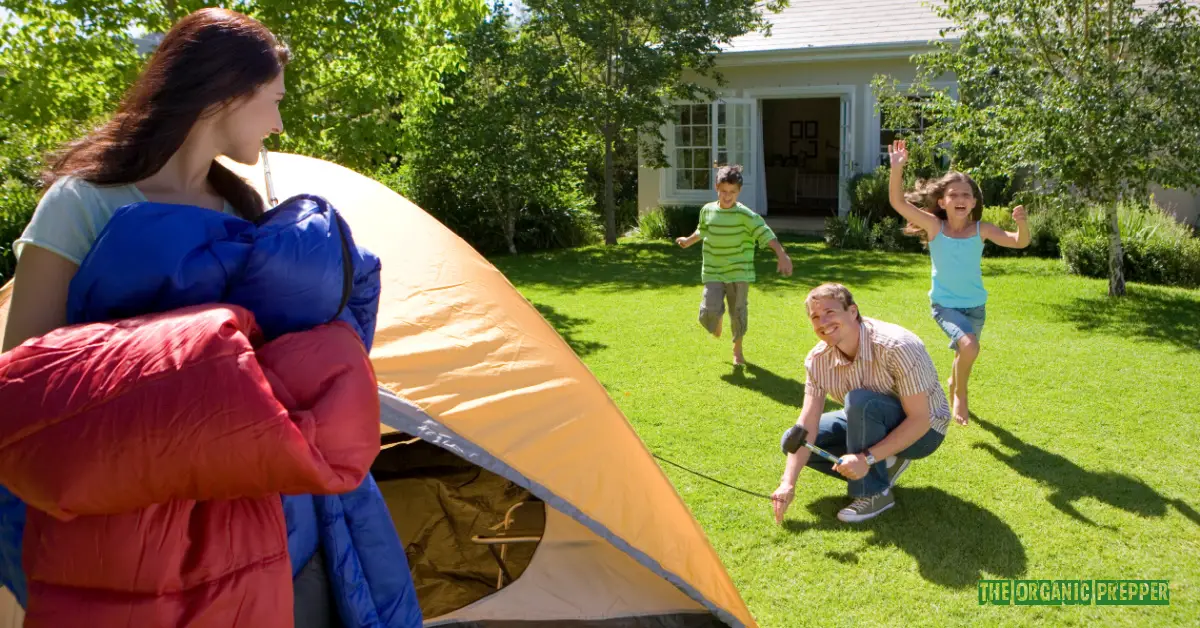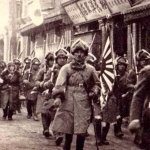

(Psst: The FTC wants me to remind you that this website contains affiliate links. That means if you make a purchase from a link you click on, I might receive a small commission. This does not increase the price you’ll pay for that item nor does it decrease the awesomeness of the item. ~ Daisy)
By the author of Street Survivalism: A Practical Training Guide To Life In The City and The Ultimate Survival Gear Handbook
As a long-time practitioner, I’m a big promoter of outdoor sports and activities, particularly backpacking and camping. Besides the physical and mental benefits of exercising around beautiful places and fresh air, spending time in nature, and dealing with weather and other challenges with minimal gear and supplies, these activities force us to think about the basics of life support and comfort in practical and realistic manners. There’s no need to comment on the importance of that for preparedness and survival.
I’ve already written about Stealth Camping and Outdoor Overnighters, now it’s time to take a look at Backyard Camping. It’s a much more common tradition in the US and Canada than in my country – or at least it was – so much so that I got into backyard camping when I spent time studying in Colorado in the 90s.
Backyard camping fits well into my proposition of using our environments to practice preparedness. I advocate for that mainly because that’s what we’ll have to contend with in case some crisis or SHTF strikes, but also because our houses, streets, buildings, offices, and parks offer the perfect ground, making it easier and thus more sustainable to integrate preparedness training into our everyday routine. That’s the essence of my Street Survivalism Training concept and also my upcoming book on Household Preparedness Training, which will go live in September.
Natural development
Many dream of great adventures in long trails, high mountains, beautiful waterfalls, and exuberant forests. The wilderness is highly rewarding, but also very unforgiving. Realistically, bigger and longer adventures are very hard and involve considerable risks. Anyone looking at this lifestyle should start small and develop slowly, with time.
There are ways to enjoy many of the great outdoors’ benefits with low risks, gaining experience and confidence while still advancing on the learning curve. One is “regular” camping, which consists of setting up a tent or hammock inside a dedicated campsite with many typical household installations and conveniences: security, clean water, toilets, power outlets, lights, etc.
One step above is stealth camping in public or private areas, which involves more elaborate social and outdoor skills. Next are short-duration guided/group hikes and trekking trips. Finally, there are bug-out dry runs, a mix of backpacking and stealth camping with a heavy dose of tactical and strategic considerations (that’s the theme of my third book, coming out later this year). Depending on where you live, you may find even more options and variations of outdoor adventures, but that’s basically it.
I rank backyard camping at the bottom of the scale as the easiest, safest, yet still highly enjoyable way to ease into the outdoor lifestyle. You’re safe and close to home but simultaneously exposed to the elements, with limited, finite resources. There’s more: depending on how you set yourself up, backyard camping can be used in very practical ways, so keep reading.
Equipment maintenance
I live in a small apartment in a big city, but my parents live in a little ranch on the outskirts of a small rural town about two hours from here. Whenever I visit them (every month or two), I camp outside in the middle of the trees rather than staying in the main house.
Basically, I spend the day with the old folks and everyone else but sleep in my tent or the hammock. That way, I can test and become more familiar with the gear (more on that in a moment). But, most importantly, I can perform proper maintenance on the equipment, which is almost impossible during a real backpacking or camping trip.
While in the backyard, I have the time, tranquility, and tools I need to inspect item by item in greater detail, then wash, dry, clean, stitch, fix, replace, straight, sharpen, etc., much more thoroughly than I ever could in my tiny apartment, and certainly out in the nature. It’s a lot better for OPSEC, too, because I can do all that far from the eyes of strangers.
Develop skills (and keep them sharp)
A “real” outdoor trip can accelerate the learning curve quite a bit, but everything considered, it’s about “time in the saddle,” as we say in cycling, so everything counts. Furthermore, backyard camping takes away a lot of the pressure and reduces the risks, allowing the kids, friends and other relatives to participate.
What I mentioned in both articles about Stealth Camping and Outdoor Overnighters is also valid for Backyard Camping: they’re great for developing and fine-tuning outdoor techniques to mastering or honing various survival skills, many of which can only be practiced in the wilderness or semi-rural settings to provide a much more complete experience.
It’s also a way to fine-tune “prepping” skills by thinking ahead everything you need to go out and stay out. For that, make a rule to remain outside. If you forgot something, do without it, or improvise. If you get caught in a storm, or the temperature drops at night, hold tight.
Of course, don’t put yourself in danger. Use common sense, but work your judgment, sharpen your senses, and expand your limits. Learn from your mistakes, improve next time, and integrate the lessons. Develop selective skills to take what you need (essentials) and leave behind what you don’t, according to the occasion, season, etc.
Test new gear
Taking a new knife, stove, or tent on a long or challenging trip isn’t advisable, no matter how many reviews you’ve read on websites or videos you’ve watched on YouTube.
It is better and more effective to test it a few times in a controlled and safe environment without worrying about storms, sudden weather changes, animals, insects, other people, and so on. If something goes wrong, we can bug in and start again the next day or week without any harm or loss. That allows us to focus on the new item(s) and get used to how it performs.
Build confidence (in gear and skills)
This goes along with the above. It takes time and experimentation to test a new piece of gear and even more to develop familiarity with it. One reason I started Street Survival Training and Household Preparedness Training was to practice more often without waiting for a more extended and demanding journey.
Now, if you’re like most people you already have a lot in your day: work, family, social life, and so on. I can say for myself that I don’t have enough free time or money to go on a “real outdoor trip as much as I’d like to. Nowadays, I’m lucky if I can squeeze a bug-out-dry run or a mountain pass four or five times per year.
That’s OK. I’m not complaining. But I’m also not getting younger, so I must create ways and opportunities to do what I want (or need) regardless of other life commitments. Adding stealth camping, outdoor overnighters, and backyard camping here and there can fill that blank and increase my training (and fun) time considerably without disrupting my everyday routine or requiring extensive preparations.
It’s easier to get children into camping and outdoor lifestyles
Get them early while you can. I was a Boy Scout, and it’s hard to say for sure but I believe that helped get me into the outdoor lifestyle. It’s also hard to express how joyful and fun it was to go camping and learn to start fires, pitch tents, tie knots, read maps, all those simple, basic things that may have gotten lost with the advent of the internet, video games, and smartphones, but that never loses importance.
I’m not criticizing technology. I use it all the time, but even today, I get more satisfaction from finding my bearings using a compass or the stars than typing an address on a GPS or Google Maps. And I believe humans haven’t changed that much since the 1970s or 80s; it’s just a matter of finding simple ways to add challenge and fun to backyard camping days and nights so everyone can enjoy it.
My point is that backyard camping is a great way to get kids into camping and the outdoor lifestyle. An adult may not feel much thrill from sleeping in a tent so close to home, but children will for sure because there’s all the noises and sounds (or lack thereof), the wind, the exposure, and the new stuff and lessons that require a whole set of skills and abilities from what they’re used to from their everyday lives. And children thrive on new and challenging stuff.
Getting creative
Adding games and challenges can make things even more fun and exciting, particularly for those camping in the backyard with children. We constantly develop new and creative ideas to keep them interested and increase the difficulties. Kids love challenges and, above all, learning new skills and stuff; they’re like sponges. Here are a few ideas:
- Turn it into a competition by assigning points every time someone has to go indoors for something (fewer points wins);
- Try foraging, flashlight foraging, treasure hunts;
- Games and challenges such as identifying the plants, stars, also noises and sounds (birds, etc.).
- Depending on their age, you can teach more advanced skills such as fire starting, knot tying, cooking (why not trying new recipes?), map reading, etc.
- Even storytelling can be very different when camping in the backyard.
- When it comes to gear and communication, you can introduce them (or yourself, if you haven’t already) to HAM radio, Morse Code (using flashlights or sounds), or use walkie-talkies to chat or play games. Short-wave monitoring is also a blast, I guarantee.
- I like to play situational awareness games; depending on the settings, we’ll work on perimeter security and other strategic activities;
- It can start during the week, by working on packing skills and similar themes. Teach them to pack a camping bag, or even an emergency or bug-out bag.
- Be creative and keep adding new ideas; one day, they’ll start to come up with their own.
Live in an apartment and don’t have a backyard?
That shouldn’t be a problem, at least not one you can’t overcome. If there’s a will, there’s a way.
For instance, you can go camping at a proper campsite just outside of town. Or even inside: around here, we have “urban campings,” which are larger properties that accept tents, hammocks, or even cars for a fee. If you choose correctly, it’ll be just as safe and convenient as a backyard, with the bonus of being away from home and perhaps with good company around the campfire.
Maybe – as is my case – you have friends or relatives who live in a house with a backyard where you can set up camp occasionally. I’ve created groups of like-minded people among a few I consult for; they rotate between each other’s backyards to vary the environment and the experience. Once per month, the group gathers in someone’s backyard, and sometimes, they switch tents and other gear to experiment and exchange impressions and experiences.
What about you?
Do you do any backyard camping? What skills has it helped you with? If not, what’s holding you back?
Let’s discuss this in the comments section.
About Fabian
Fabian Ommar is a 50-year-old middle-class worker living in São Paulo, Brazil. Far from being the super-tactical or highly trained military survivor type, he is the average joe who since his youth has been involved with self-reliance and outdoor activities and the practical side of balancing life between a big city and rural/wilderness settings. Since the 2008 world economic crisis, he has been training and helping others in his area to become better prepared for the “constant, slow-burning SHTF” of living in a 3rd world country.
Fabian’s ebook, Street Survivalism: A Practical Training Guide To Life In The City , is a practical training method for common city dwellers based on the lifestyle of the homeless (real-life survivors) to be more psychologically, mentally, and physically prepared to deal with the harsh reality of the streets during normal or difficult times. He’s also the author of The Ultimate Survival Gear Handbook.
You can follow Fabian on Instagram @stoicsurvivor


